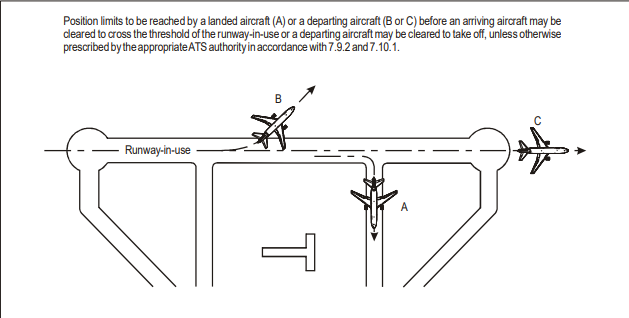Runway Separation
Only one aircraft may occupy a runway at a time. Takeoff or landing clearance must not be issued if another aircraft is occupying the runway unless specific conditions allow otherwise.
A departing aircraft will not normally be cleared for takeoff until:
- The preceding departing aircraft has crossed the end of the runway-in-use or has started a turn.
- All preceding landing aircraft are clear of the runway-in-use.
- Takeoff clearance may be issued when there is reasonable assurance that prescribed separation will exist at the time of departure.
- If an ATC clearance is required before takeoff, it must be transmitted and acknowledged before issuing the takeoff clearance.
- The takeoff clearance must be issued when the aircraft is ready for departure and at or approaching the departure runway. The runway designator must be included to avoid misinterpretation.
- An immediate takeoff clearance may be issued before the aircraft enters the runway, requiring the aircraft to taxi onto the runway and depart in one continuous movement.
A landing aircraft will not normally be permitted to cross the runway threshold unless:
- The preceding departing aircraft has crossed the end of the runway-in-use or started a turn.
- All preceding landing aircraft are clear of the runway-in-use.
To expedite traffic, a landing aircraft may be instructed to:
- Hold short of an intersecting runway after landing.
- Land beyond the touchdown zone. (Not applicable to HEAVY aircraft.)
- Vacate the runway at a specified exit taxiway.
- Expedite vacating the runway.
Controllers must consider aircraft type, runway length, exit locations, braking action reports, and weather conditions when issuing such instructions. If a pilot is unable to comply, they must inform ATC immediately.
When necessary, such as in low visibility, an aircraft may be instructed to report when it has vacated the runway. The report must be made after the entire aircraft is beyond the relevant runway-holding position.
Reduced runway separation
Intersecting runways
Many airports use intersecting runways to accommodate varying wind conditions or maximize efficiency in limited space. Proper separation procedures must be followed to ensure safe operations.
Departure Following a Departure
When two aircraft are departing from intersecting runways, the second aircraft may only begin its takeoff roll if one of the following conditions is met:
- The first aircraft has taken off and initiated a turn that ensures safe separation, or
- The first aircraft has completely crossed the intersection.
Departure Following an Arrival
If a landing aircraft is on the intersecting runway, the departing aircraft may only begin its takeoff roll when:
- The landing aircraft has fully vacated the runway, or
- The landing aircraft has stopped before the intersection as instructed and completed its landing roll, or
- The landing aircraft has crossed the intersection.
Arrival Following a Departure
If an arriving aircraft is following a departing aircraft on an intersecting runway, the arriving aircraft may only cross the runway threshold when:
- The departing aircraft has taken off and initiated a turn that maintains separation, or
- The departing aircraft has completely crossed the intersection.
Arrival Following an Arrival
For two landing aircraft on intersecting runways, the second aircraft may only cross the runway threshold if:
- The first aircraft has vacated the runway, or
- The first aircraft has stopped before the intersection as instructed and completed its landing roll, or
- The first aircraft has crossed the intersection.
Simultaneous landings on intersecting runways are only permitted under the following conditions:
- One of the intersecting runways must have at least 2200 meters of available distance between the threshold and the intersection.
- Additional conditions must be met:
- Visual Meteorological Conditions (VMC) must exist.
- Braking action must not be negatively affected.
- Both aircraft must be informed of the simultaneous landings.
- The aircraft landing on the 2200m runway must stop before the intersection as instructed.
| Scenario | Condition for Second Aircraft to Proceed |
|---|---|
| Departure following a departure | First aircraft has either crossed the intersection or initiated a turn. |
| Departure following an arrival | Landing aircraft has vacated the runway, stopped before the intersection, or crossed the intersection. |
| Arrival following a departure | Departing aircraft has crossed the intersection or initiated a turn. |
| Arrival following an arrival | First arriving aircraft has vacated the runway, stopped before the intersection, or crossed the intersection. |
Opposite direction
Three-minute wake turbulence separation for following aircraft:
Two-minute wake turbulence separation for opposite-direction take-off:
Two-minute wake turbulence separation for opposite-direction landing:

